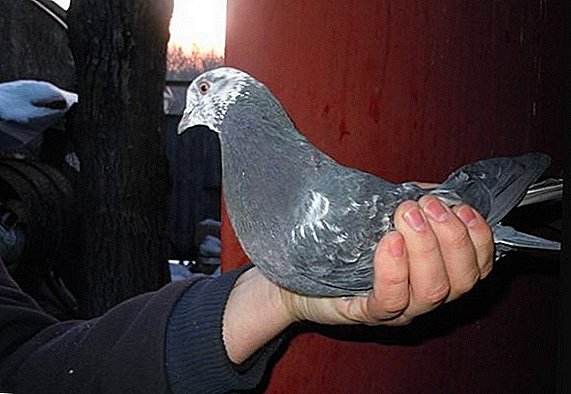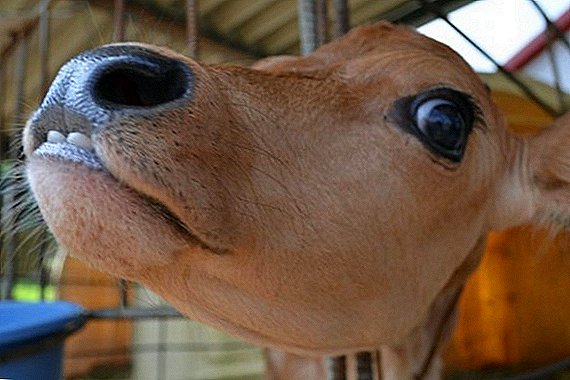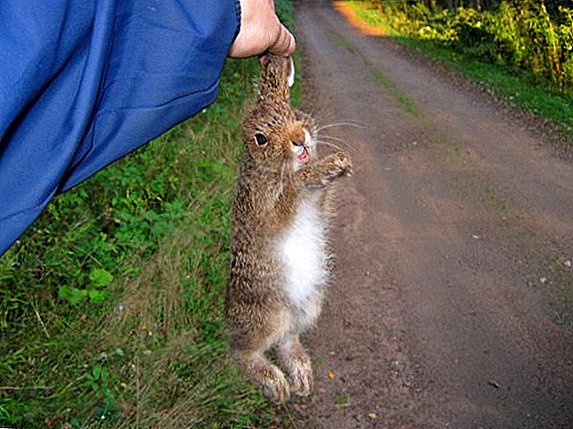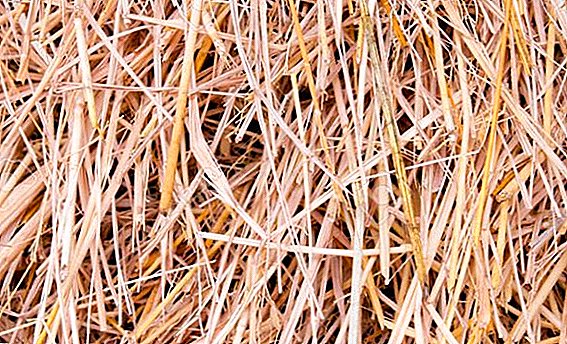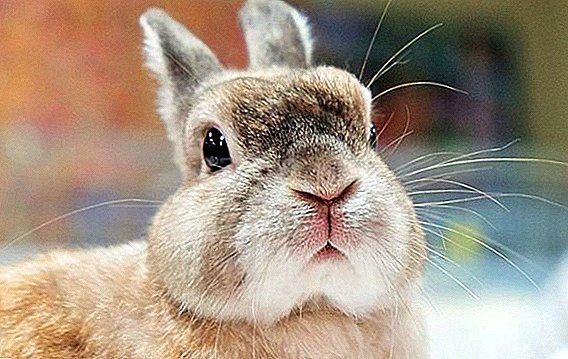 For villagers or summer residents who decide to grow several pairs of rabbits for themselves in their shed, it makes no sense to brand their animals, since each of them can be remembered "in person".
For villagers or summer residents who decide to grow several pairs of rabbits for themselves in their shed, it makes no sense to brand their animals, since each of them can be remembered "in person".
But taking up the rabbit breeding professionally, one cannot do without this procedure, otherwise such a business will never be successful.
Why do the markings of rabbits on the ears
Branding (or branding) in animal husbandry is the imprinting of a special indelible mark on the body of an agricultural animal that contains certain information about this particular individual. This procedure is necessary to account for livestock and the ability to quickly recognize each member of the herd.  In particular, in rabbit breeding, branding allows to solve the following tasks:
In particular, in rabbit breeding, branding allows to solve the following tasks:
- quickly and accurately divide the animals into the main herd and maintenance population;
- to separate from each other individuals intended for breeding, sale, slaughter, etc .;
- not to allow inbreeding (mating of closely related individuals) in the process of carrying out breeding work, thus preventing the degeneration of animals and the emergence of non-viable offspring;
- to consider when breeding rabbits, in addition to kinship and breeding pedigree lines, the individual characteristics of individual individuals (animals reproduce in different ways, noting the most prolific, a successful farmer will leave them for further breeding, and remove “outsiders” from the parent flock);
- the presence of the stamp is a prerequisite for the participation of the animal in exhibitions, as well as for its export / importation across the state border: only by comparing the data specified in the accompanying documents, pedigree, etc., with the information stamped on the stamp, the specialist can identify the relevant individual and exclude smuggling opportunities;
- even in the sale of rabbits on the domestic market, the presence of their marks is welcome, since in this case the buyer can already exclude the forgery, respectively, the seller’s trust increases.
Important! Branding is a prerequisite for carrying out certain actions with the animal, however, in addition, the brand is a very useful procedure for the farmer himself, since it allows keeping correct livestock accounting and avoiding serious mistakes in work. Branding is recommended if the number of females in the herd exceeds ten individuals.
Some beginner breeders solve the problem of storing information about their wards by fixing various types of tablets on cages or aviaries.  However, practice shows that such a path does not justify itself: sooner or later, such information is lost, forgotten, ceases to be updated, the plates are confused among themselves, the animals contained in the cages move, and the inscriptions remain in place ...
However, practice shows that such a path does not justify itself: sooner or later, such information is lost, forgotten, ceases to be updated, the plates are confused among themselves, the animals contained in the cages move, and the inscriptions remain in place ...
It is possible to reliably fix information about an individual in only one way: specify the data about it directly on its body, moreover, so that they will not be washed away and not erased.
Ways of branding
We approached the main question facing the farmer who decided to tag each of his rabbits: how to carry out the procedure so that the information to be kept is not lost throughout the life of the animal. There are several ways to solve this problem.
Marker or gel pen
If it is not about meeting state requirements, but about the possibility of distinguishing one's own animals among themselves, the farmer can resort to any means that are convenient for him.
The most simple and painless for an animal is a usual indelible marker (for example, used to sign CDs) or a gel pen. On the inside of the ear of each animal, any information of interest to the breeder is applied with a writing device - and the problem is solved. True, temporarily.  Usually, after a couple of months, the traces of homemade “stamp” are erased and the contents of the labels cannot be disassembled. To avoid this, you only need to timely update the records.
Usually, after a couple of months, the traces of homemade “stamp” are erased and the contents of the labels cannot be disassembled. To avoid this, you only need to timely update the records.
Important! There are special pencils for marking animals, in particular, made in China. They are inexpensive (a little more than 1 dollar), the term of use is unlimited, the composition of the paint includes wax and paraffin oil, which makes it very easy to apply information both to the skin and to wool.
There are other ways to distinguish animals in their own farm. For example, some cut a small tuft of wool from a rabbit in a certain part of the body. This method is also temporary (in a month the wool grows), besides, it is less informative.
However, if it is necessary to separate the members of the herd by one specific attribute, which implies only two possible answers (for example, boys from girls or vaccinated animals from unvaccinated), this option is quite justified.
Earrings (clips)
A more reliable method of marking is clips (similar tags can be seen on the ears of stray dogs). The disadvantage of this method is only in the need to purchase tags for each individual animal.  The cost of one clip is small (6 pieces cost about $ 1), but if the herd is large, the costs can be significant, and the manufacturer does not provide for the reuse of the ear-ring. There is usually no information on the tag itself, the farmer himself can apply it at his own discretion.
The cost of one clip is small (6 pieces cost about $ 1), but if the herd is large, the costs can be significant, and the manufacturer does not provide for the reuse of the ear-ring. There is usually no information on the tag itself, the farmer himself can apply it at his own discretion.
Did you know? Branding a living product, people started a long time ago, according to some information, it happened more than a thousand years ago. The original purpose of this procedure was to secure the ownership of movable property, but it is interesting that the first creatures that began to be supplied with indelible stigma were humans. In addition to slaves, criminals were also designated as a kind of seal.
As a rule, the tag indicates the numbers corresponding to the accounts of the owner of the rabbitry. In addition, the clips vary in color, which is also an additional method of identification.
Klimator (tattoo pen)
In order not to get confused in the terminology, we will clarify that the word "klamator" actually means two types of tools for marking animals: a tattoo pen and forceps.
The tattoo pen is a simple device for applying a tattoo on the skin of an animal. Unlike a marker or even a special pencil, it provides a fairly reliable marking, since it involves the sticking of necessary information with a needle containing ink (black ink).  In the absence of sufficient experience, it is recommended that you first apply the necessary information to the rabbit's skin with a pen or any other writing device, and then follow the finished sketch with a machine that delivers ink under the skin. Having thus filled the hand, it is possible later to do without a preliminary “sketch”.
In the absence of sufficient experience, it is recommended that you first apply the necessary information to the rabbit's skin with a pen or any other writing device, and then follow the finished sketch with a machine that delivers ink under the skin. Having thus filled the hand, it is possible later to do without a preliminary “sketch”.
Familiarize yourself with the best representatives of meat rabbits, ornamental rabbits, broiler rabbits, giant rabbits, down and fur rabbits.
Tattoo forceps
The second type of the appliqué is tattoo pliers. The principle of their work is similar to a pencil, but in this case a panel with small needles arranged in the form of certain letters and numbers is used (you can type any combination at your discretion).
At first, such a panel is applied to the skin, creating wounds on it of a given configuration, and then tattoo paste mixed with anesthetic (Novocain) is rubbed into the treated area.
Pasta is not always included in the set with tattoo forceps, because it is a consumable material, therefore, when purchasing an instrument, you should pay attention to this.
After a certain time, the dye from healthy skin is erased, remaining only in the place of punctures and, thus, there is a readable stigma.
Oddly enough, the tattoo tattoo forceps are considered to be a much less painful procedure than using a tattoo pen, mainly because it occurs much faster and is accompanied by anesthesia.  However, in order for this rule to work, certain conditions must be met, namely:
However, in order for this rule to work, certain conditions must be met, namely:
- hard hand at the performer;
- a quality tool with a high needle speed (experts recommend giving preference to products of German or at least Belarusian production, it is undesirable to buy goods from China or Korea);
- correct fixation of the animal.
Chipping
Chipping is the most civilized way of tying the necessary information about a pet to an individual. Strictly speaking, it cannot be considered a kind of branding; rather, it is its modern alternative, adopted today in most developed countries.
Important! For participation in exhibitions and transportation outside the state, it is precisely the presence of a chip, and not a stamp applied by the pen or a tattoo, that is required by the pen.
The advantages of this procedure include the fact that the chip:
- it is introduced for life, it is impossible to lose it, and the information applied to it, unlike a tattoo, will not be washed away and not erased;
- contains a unique 15-digit number entered in a special register, which allows you to find a valuable animal in case of his theft, loss, substitution;
- may contain the most complete information about the animal, which is usually physically impossible to apply to the stigma (breed, nickname, date of birth, owner, data on vaccinations, etc.). It is important to understand that the information about the animal in the chip itself is missing, but it is contained in the registry, being assigned to a certain chip number, and can be changed and supplemented if necessary;
- put quickly and painlessly, the procedure is not associated with the risk of injury, the introduction of infection, stress and other complications, as when applying a tattoo.
 However, chipping has some drawbacks. To install a microchip, you must contact the veterinary or other specialized service. For the sake of fairness, we note that it is better to entrust the implementation of the marking to a specialist, but for chipping this condition is obligatory and not desirable.
However, chipping has some drawbacks. To install a microchip, you must contact the veterinary or other specialized service. For the sake of fairness, we note that it is better to entrust the implementation of the marking to a specialist, but for chipping this condition is obligatory and not desirable.Did you know? The largest rabbit in the world lives in London. The length of its body is 1 m 30 cm and, according to the owner, this is not the limit, as the animal continues to grow. But the smallest usastik is registered in North America. The baby weighs only 350 g.
Apart from the fact that the obligatory involvement of a specialist in itself is associated with inconveniences and additional costs, the chip itself will also cost a tidy sum, that is, the costs of chipping and branding are incomparable.
Finally, information from a chip can only be considered using a special device (scanner); it cannot be “seen” with the naked eye.
At what age is better to do
Chip rabbit can be at any age. It is clear that you can also draw the necessary inscriptions with a marker on the ears of the animal or cut small identification shreds out of the wool from it at any time. However, there are well-defined limitations with regard to the use of the klamator.
The tattoo is applied to rabbits at the age of 28-45 days, usually this happens simultaneously with the weaning of the young from the mother, and it is better - a few days before, in order to minimize stress. In a more adult animal, the skin becomes coarser, and the cartilage tissue becomes harder.  Accordingly, it is much more difficult and painful to apply the necessary information to the ear for the animal itself. However, in some cases, the branding of adults may be carried out (for example, with the purchase of a new animal that does not have a stamp applied).
Accordingly, it is much more difficult and painful to apply the necessary information to the ear for the animal itself. However, in some cases, the branding of adults may be carried out (for example, with the purchase of a new animal that does not have a stamp applied).
The method of applying the stigma using tattoo forceps
If the breeder decided to brand his flock on his own, it is very important to comply with all sanitary and technological requirements to minimize risks and side effects.
Important! Properly performed procedure should take no more than two (maximum five) minutes. Masterfully executed branding ends before the rabbit has time to get scared.
So, the procedure itself:
- Prepare a place for the "operation". Spread out the tools and necessary materials (cotton pads, a cloth for removing paint, disinfectant, paint itself, etc.) at a convenient distance from yourself.
- Wear rubber gloves.
- Type on the panel of the radiator the required order of numbers. This should be done in such a way that when printed, they would be placed towards the tail, and not towards the nose of the animal, otherwise it would be inconvenient to read them upside down.
- Place the panel in the bed of the forceps.
- Conduct a thorough disinfection of the working surface of the forceps with alcohol or iodine solution.
- Take the rabbit in your hands, sit it on the prepared horizontal surface.
- For local anesthesia, attach a previously prepared piece of ice to the inner surface of the ear for a few seconds.
- Wipe the place of the future puncture disinfectant.
- With one hand (you can turn to the assistance of the assistant) cover the kid's eyes.
- Take the forceps in the other hand and squeeze their ear with the fastest and most accurate movement. The place to apply the stigma should be located at a maximum distance from the edge of the ear, because it is there that the greatest number of blood vessels are located along the perimeter, damage to which is not only dangerously heavy bleeding, but can also lead to subsequent dysfunction of the thermoregulation in the body. Choosing a place for the stigma, you also need to bypass the vein that passes through the center of the rabbit's ear; it should be found and carefully considered at the preparatory stage. Ideally, the stamp is applied in the upper part of the ear slightly closer to the outer edge. Also, do not exert excessive effort when working with forceps, as this is fraught with pinched ear.
- Immediately after piercing, apply paint to the appropriate area and rub gently into the skin. If necessary, remove residue with a cotton pad or a cloth moistened with alcohol or glycerin.
- Release the animal and enter the data, encoded in the stamp, in your documentation.

Do I need a special stamp code
The question of how to encode the stigma, each farmer decides for himself.
But if we are talking about a large farm or considering the possibility of professional work with livestock (exhibitions, export, sale of breeding animals), it is better to use generally accepted coding rules, specifying them with colleagues depending on the intended use direction, since the norms in different cases may vary.
It will be useful for you to learn how to build a shed, cells using the Zolotukhin method, a queen cell, an open-air cage and a house for rabbits with your own hands. And also learn how to make troughs and drinkers for rabbits yourself.
For example, the application of a stigma on both ears of an animal is widely used, with each ear and each number carrying very specific information, namely:
- the number corresponding to the ordinal number of the animal on the farm is put on the right ear (the reference point is reset to zero every year, that is, every time it starts from one);
- a number consisting of several numbers indicating the month, year of birth, number of the structural unit (brigade, department, farm) is put on the left ear. For example, the number 398 on the craw's left ear means that the animal was born in September 2018 in department No. 3.
Experts also advise you to encrypt information about the sex of a rabbit in a stamp so as not to waste time on its definition, as well as on its pedigree. In the first case, you can use even and odd numbers when applying the mark on the right ear, in the other - the letters corresponding to the lines of both parents. 
Possible complications
Branding is quite a painful procedure for an animal and, moreover, is associated with serious psychological stress. The situation may be aggravated by the breeder's inexperience, poor-quality tools, as well as the individual characteristics of the animal (the level of the pain threshold).
Important! According to the degree of danger, marking an animal can be compared to tattooing a person’s skin: even with good disinfection and a disposable tool, the risk of suppuration, inflammation or an allergic reaction to the coloring matter always remains.
It is also possible to minimize the likelihood of negative consequences due to the fact that the rabbits, after marking, return back to their mother and remain with her for another week.
Practice shows that this simple trick allows an animal to transfer stress much easier and calm down faster, and, as you know, mental suffering (strong fear) reduces immunity and, therefore, slows down the healing process.
Nevertheless, the depressed state of the animal after the marking, which lasts up to one week, is considered normal.  During this period, rabbits can lose weight or slow down their growth, therefore, as a preventive measure, before the procedure, animals are given anti-stress drugs and vitamins for five days in the following dosage per 1 kg of body weight:
During this period, rabbits can lose weight or slow down their growth, therefore, as a preventive measure, before the procedure, animals are given anti-stress drugs and vitamins for five days in the following dosage per 1 kg of body weight:
- ascorbic acid - 20-30 mg;
- nicotinic acid (vitamin PP) - 6 mg;
- thiamine (vitamin B1) - 0.4 mg;
- рибофлавин (витамин B2) - 0,4 мг;
- пиридоксин (витамин B6) - 0,4 мг;
- аминазин - 0,5 мг.
Such a preventive cocktail allows the rabbit to move an unpleasant procedure much easier.
Stamp in a rabbit is a kind of animal passport. Of course, it is possible to live life without documents, if you do not leave your home from birth to death, but in relation to larger farms, livestock registration requires the personification of each individual.
For this reason, it is recommended that all breeders should resort to stamping, even if done with a conventional marker, regardless of whether they raise animals for their own needs or as a source of permanent income.




